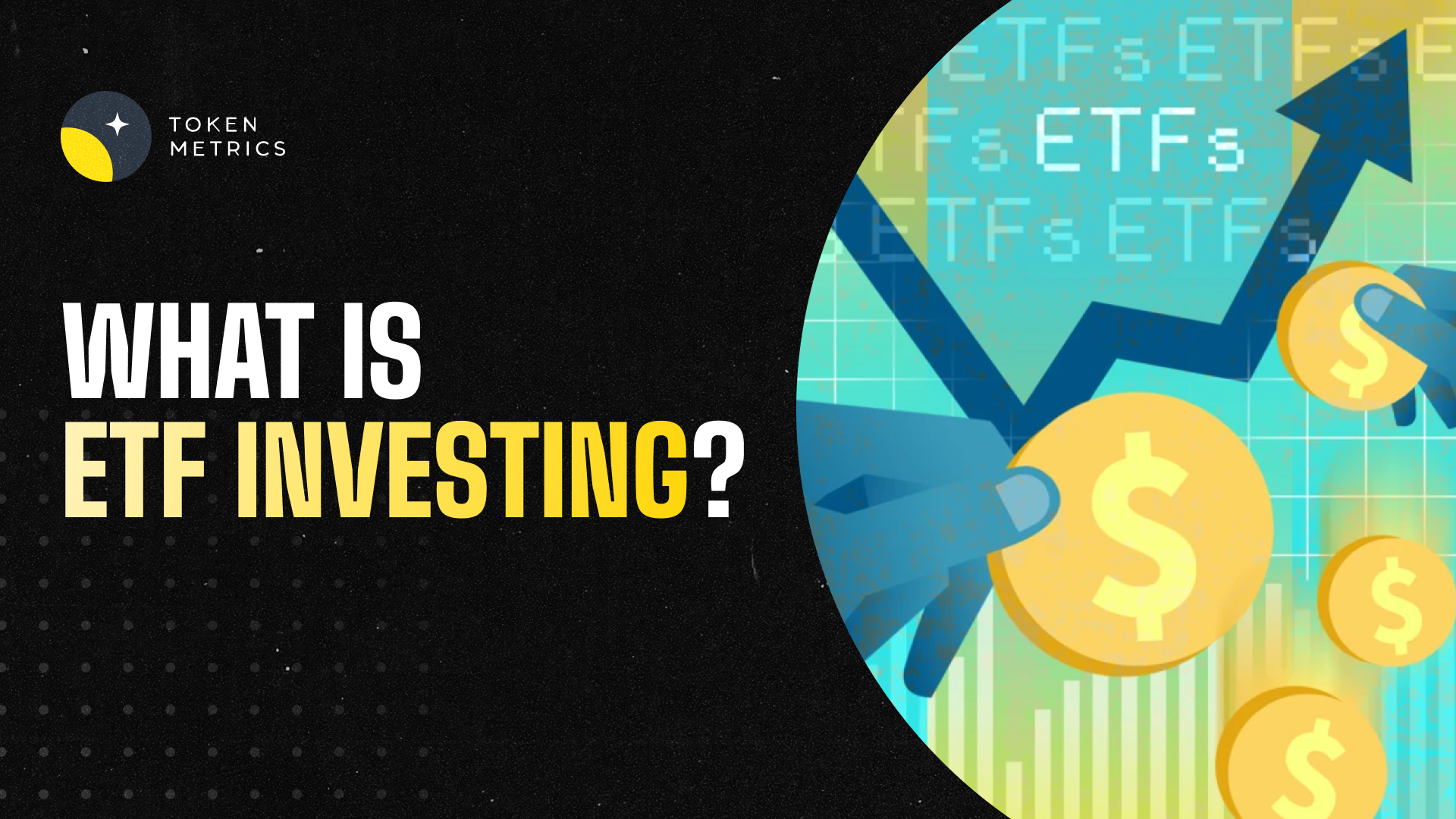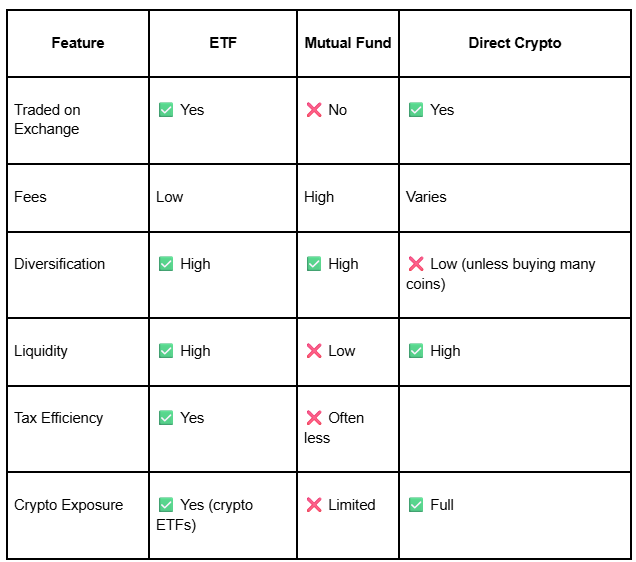What Is ETF Investing? A Complete Guide for Beginners in 2025

ETF investing is one of the smartest and most accessible ways to grow your wealth in 2025. With over $12 trillion in assets globally, Exchange-Traded Funds (ETFs) have become a go-to strategy for investors seeking low-cost, diversified, and flexible exposure to a wide range of markets — including stocks, bonds, commodities, and even cryptocurrencies.
In this guide, we’ll explore:
- What is ETF investing?
- How ETFs work
- Different types of ETFs
- Benefits and risks of ETF investing
- How to use platforms like Token Metrics to make better investment decisions, especially with crypto ETFs
📌 What Is ETF Investing?
ETF investing refers to buying and holding shares of an Exchange-Traded Fund (ETF) — a marketable security that tracks a collection of assets such as stocks, bonds, or digital currencies. ETFs are traded on public exchanges just like individual stocks, meaning you can buy or sell them anytime during market hours.
Unlike mutual funds, ETFs are passively managed and aim to replicate the performance of a particular index or sector. For example, the SPY ETF tracks the S&P 500, giving you exposure to 500 of the largest U.S. companies with a single investment.
🔍 How Does an ETF Work?
An ETF is managed by an investment company that holds the actual basket of assets. This company issues shares that represent fractional ownership of the entire portfolio.
Here’s how ETF investing works in practice:
- You buy ETF shares on a stock exchange through a broker (just like buying a stock).
- The ETF provider holds the underlying assets (e.g., stocks, bonds, crypto).
- You gain exposure to all assets in the fund with one transaction.
- ETF price moves with the market value of its underlying assets.
This model provides instant diversification, reducing risk and simplifying portfolio construction.
🔍 What Are the Types of ETFs?
In 2025, ETF investing is more versatile than ever. Investors can choose from a variety of ETFs depending on their risk appetite, market outlook, and investment goals.
1. Equity ETFs
Track a group of stocks, either broadly (e.g., S&P 500, Nasdaq) or thematically (e.g., AI, electric vehicles, cybersecurity).
2. Bond ETFs
Offer exposure to government or corporate bonds, ideal for income investors seeking lower volatility.
3. Commodity ETFs
Provide access to raw materials like gold, silver, oil, or agricultural goods — useful as inflation hedges.
4. Thematic ETFs
Focus on emerging trends like blockchain, green energy, Web3, or metaverse industries.
5. Crypto ETFs
New in 2025, these ETFs give regulated exposure to digital assets like Bitcoin, Ethereum, and altcoins without managing wallets or private keys.
✅ Benefits of ETF Investing
ETF investing offers many benefits for both beginners and experienced investors:
1. Diversification
One ETF share exposes you to dozens or even hundreds of assets, reducing portfolio risk.
2. Low Fees
ETFs typically have lower expense ratios (0.03%–0.75%) compared to mutual funds (1%+), allowing you to keep more of your returns.
3. Liquidity
ETFs are traded on public exchanges, so you can buy and sell throughout the day, unlike mutual funds that settle once daily.
4. Transparency
Most ETFs disclose holdings daily, so you know exactly what you own.
5. Tax Efficiency
Due to their structure, ETFs are often more tax-friendly than other pooled investment vehicles.
⚠️ Risks of ETF Investing
While ETF investing has many advantages, there are a few risks to consider:
1. Market Risk
Your ETF will rise or fall with the market it tracks. If the S&P 500 drops, so does the SPY ETF.
2. Tracking Error
An ETF may not perfectly match the index it tracks due to fees or poor asset replication.
3. Over-Concentration
Some ETFs are heavily weighted in a few assets, which can increase volatility.
4. Liquidity Risk
Smaller or niche ETFs may have lower trading volume, making it harder to exit positions quickly.
📈 What Is Crypto ETF Investing?
In 2025, crypto ETF investing has gained significant traction. Thanks to regulatory clarity in major markets like the U.S., investors can now access:
- Bitcoin spot ETFs (e.g., IBIT by BlackRock)
- Ethereum ETFs
- Altcoin basket ETFs
- Thematic ETFs focused on DeFi, NFTs, or AI crypto
These ETFs make it easier to gain exposure to crypto assets through traditional brokerages and tax-advantaged accounts — without handling the complexity of wallets or exchanges.
🤖 How Token Metrics Enhances ETF Investing
Token Metrics is an AI-powered crypto analytics and research platform that can be used alongside ETF investing, especially when evaluating or managing crypto ETF exposure.
1. AI Price Predictions
Token Metrics uses machine learning models to forecast future prices of top cryptocurrencies — helping investors anticipate ETF performance tied to those assets.

2. Trader and Investor Grades
Each token tracked by Token Metrics receives a Trader Grade (short-term signal) and Investor Grade (long-term strength), allowing users to compare underlying assets of ETFs.

3. Real-Time Market Signals
If a crypto asset in your ETF becomes bullish or bearish, Token Metrics alerts you in real time — helping you decide whether to hold or rotate exposure.

4. Portfolio Tracking
You can sync your wallet or exchange accounts and use Token Metrics to monitor how ETF-related tokens are performing in your overall crypto portfolio.
💬 ETF Investing vs. Mutual Funds vs. Crypto

For most retail investors in 2025, ETF investing offers the best balance between simplicity, diversification, and risk management — especially when paired with tools like Token Metrics.
🧠 Final Thoughts
ETF investing is one of the most powerful tools for building long-term wealth in today’s fast-moving markets. It provides instant access to diversified portfolios across traditional and emerging sectors — including cryptocurrency.
By combining ETF investing with AI-powered insights from Token Metrics, you gain an edge in identifying opportunities, managing risk, and adapting your strategy as markets evolve.
Whether you're buying your first ETF or exploring the future of finance through crypto ETFs, now is the perfect time to put ETF investing at the core of your portfolio strategy.
Create Your Free Token Metrics Account

.png)




%201.svg)
%201.svg)


%201.svg)










.svg)




.png)